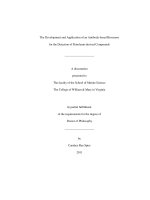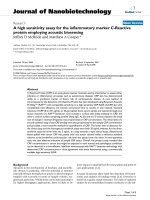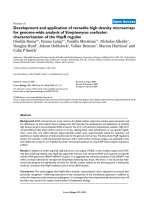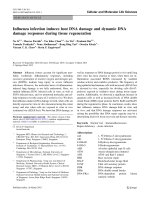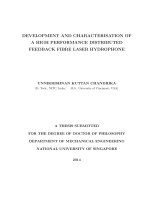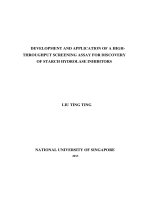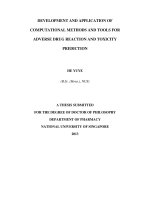Development and application of a high throughput assay for discovery of starch hydrolase inhibitors
Bạn đang xem bản rút gọn của tài liệu. Xem và tải ngay bản đầy đủ của tài liệu tại đây (2.93 MB, 225 trang )
DEVELOPMENT AND APPLICATION OF A HIGH-
THROUGHPUT SCREENING ASSAY FOR DISCOVERY
OF STARCH HYDROLASE INHIBITORS
LIU TING TING
NATIONAL UNIVERSITY OF SINGAPORE
2013
DEVELOPMENT AND APPLICATION OF A HIGH-
THROUGHPUT SCREENING ASSAY FOR DISCOVERY
OF STARCH HYDROLASE INHIBITORS
LIU TING TING
(BSc, MSc. Wageningen University)
DEPARTMENT OF CHEMISTRY
NATIONAL UNIVERSITY OF SINGAPORE
2013
A THESIS SUBMITTED
FOR THE DEGREE OF DOCTOR
OF PHILOSOPHY
i
DECLRATION
I hereby declare that this thesis is my original work and it has been
written by me in its entirety.
I have duly acknowledged all the sources of information which have
been used in this thesis.
This thesis has also not been submitted for any degree in any university
previously.
____________________________________
Liu Ting Ting
29 July 2013
ii
Acknowledgments
First and foremost, I would like to express my sincere gratitude to my
supervisor of my doctoral study, associate professor Huang Dejian for the
valuable guidance and advice. With his encouragement, I would be able to
carry on my study and complete this thesis. I also would like to thank Dr.
Zhang Dawei from Division of Chemistry & Biological Chemistry, Nanyang
Technological University, for his kindly help on my research.
Besides, I would like to thank the staff of Food Science and
Technology Program of NUS, Ms. Lee Chooi Lan, Ms. Lew Huey Lee and Ms.
Jiang Xiaohui for their kindly help during my study. I also would like to thank
Ms. Soh Yee Lyn, Ms. Chen Mei Juan and Ms. Yew Mun Yip for their
contributions in various experiments.
I wish to acknowledge Jing Brand Co. Ltd. for the financial support of
my research project and the Singapore International Graduate Award (SINGA)
for PhD scholarship.
Last but not least, I would like to extent my gratitude to my entire
family for their moral support and courage throughout the years.
iii
Table of contents
Acknowledgments ii
Table of contents iii
Summary vii
List of tables ix
List of figures x
List of abbreviations xiii
Chapter 1. Introduction - 1 -
Chapter 2. Literature review - 6 -
2.1 Starch hydrolase - 7 -
2.1.1 Starch digestion by starch hydrolase - 7 -
2.1.2 Starch hydrolase used in diabetes research - 8 -
2.2. Methods of determining starch hydrolase activity - 9 -
2.2.1 Conventional methods - 9 -
2.2.2 Turbidity measurement applications - 13 -
2.3 Starch hydrolase inhibitors - 14 -
2.3.1 Acarbose - 14 -
2.3.2 Phytochemicals as starch hydrolase inhibitors - 16 -
2.3.3 Proanthocyanidins - 16 -
2.3.4 Phenylpropanoid sucrose esters - 19 -
2.4 Functional food for diabetes patients - 21 -
Chapter 3. A high-throughput assay for quantification of starch
hydrolase inhibition based on turbidity measurement - 23 -
3.1 Introductions - 24 -
3.2 Materials and methods - 27 -
iv
3.2.1 Reagents and instruments - 27 -
3.2.2 Determination of α-glucosidase activity - 29 -
3.2.3 Determination of dynamic range of the turbidity measurement. - 30 -
3.2.4 High-throughput assay of starch hydrolase activity - 31 -
3.2.5 Determination of inhibitor activity - 33 -
3.2.6 Determination of precision and accuracy - 33 -
3.2.7 Statistical Analysis - 34 -
3.3 Results and discussions - 35 -
3.3.1 Dose response between turbidity and starch concentration - 35 -
3.3.2 Quantification of the enzyme activity - 36 -
3.3.3 Inhibitor activity - 38 -
3.3.4 Precision and accuracy……………………………………………- 40-
3.3.5 Acarbose equivalence. - 42 -
3.4 Conclusion - 49 -
Chapter 4. Amylase and sucrase inhibition activity of diboside A isolated
from wild buckwheat (Fagopyrum dibotrys) - 50 -
4.1 Introduction - 51 -
4.2 Materials and methods - 53 -
4.2.1 Assay guided fractionation of α-amylase inhibitors diboside A from
Fagopyrum dibotrys - 53 -
4.2.2 α-Amylase inhibition assay - 54 -
4.2.3 α-Glucosidase inhibition assay - 55 -
4.2.4 Inhibition kinetics of Diboside A - 56 -
4.2.5 Molecular docking study. - 57 -
4.2.6 Statistical analysis - 57 -
4.3 Results and discussions - 58 -
4.3.1 Fractionation of α-Amylase inhibitors from F. dibotrys extracts - 58 -
4.3.2 Diboside A - 63 -
4.3.3 Inhibition kinetics of diboside A on α-amylase and sucrase. - 64 -
4.4 Conclusion - 75 -
v
Chapter 5. Isolation of phenylpropanoid sucrose esters compounds from
Smilax glabra rhizomes - 76 -
5.1 Introduction - 77 -
5.2 Material and Methods - 79 -
5.2.1 Plant material and reagents - 79 -
5.2.2 Extractions - 79 -
5.2.3 α-Amylase and α-glucosidase inhibitory study on raw extracts - 80 -
5.2.4 Fractionation and isolation of bioactive components from S. glabra
rhizome - 80 -
5.2.5 α-Amylase and α-glucosidase inhibitory study on isolated compounds-
81 -
5.3 Result and Discussion - 83 -
5.3.1 α-Amylase and α-glucosidase inhibition study on raw extracts - 83 -
5.3.2 Structure identification of phenylpropanoid sucrose esters compounds
from Smilax.glabra rhizome - 86 -
5.3.3 α-Amylase and α-glucosidase inhibition activity of isolated
compounds - 91 -
5.4 Conclusion - 96 -
Chapter 6. Characterization of proanthocyanidins in wild buckwheat root
extracts - 97 -
6.1 Introduction - 98 -
6.2 Material and methods - 99 -
6.2.1 Extraction and characterization of proanthocyanidins - 99 -
6.2.2 Thiolysis of the proanthocyanidins for HPLC analysis - 99 -
6.2.3 α-Amylase inhibition assay. - 100 -
6.2.4 α-Glucosidase inhibition assay - 101 -
6.3 Results and discussions……………………………………………… -102-
6.3.1 Characterization and quantification of proanthocyanidins isolated
from Fagopyrum dibotrys rhizome by HPLC-MS. - 102 -
6.3.2 Thiolyzed products of the proanthocyanidin - 107 -
vi
6.3.3 Inhibition activity of wild buckwheat proanthocyanidins on α-amylase
and α-glucosidase - 109 -
6.4 Conclusions - 111 -
Chapter 7. Effects of grape seeds extracts on sensory properties and in
vitro digestibility of wheat noodles - 112 -
7.1 Introduction - 113 -
7.2 Materials and methods - 115 -
7.2.1 Reagents and instruments - 115 -
7.2.2 Determination of IC
50
value of grape seed extracts - 115 -
7.2.3 Determination of grape seed extracts total phenolic content - 116 -
7.2.4 Determination of proanthocyanidin profile of grape seed extracts-116-
7.2.5 Formulation of GSE incorporated wheat noodles - 117 -
7.2.6 In vitro digestion model of GSE- incorporated noodle samples - 117 -
7.2.7 Determination of grape seeds proanthocyanidin cooking loss - 118 -
7.2.8 Sensory evaluation and consumer acceptance - 119 -
7.3. Results and discussions - 120 -
7.3.1 Determination of total phenolic content of grape seeds extracts . - 120 -
7.3.2 Determination of the proanthocyanidin profiles of grape seeds extracts
- 120 -
7.3.3 Determination of IC
50
values of the grape seed extracts - 123 -
7.3.4 Formulation of grape seed wheat noodles - 126 -
7.3.5 In vitro digestion of GSE-incorporated wheat noodles - 128 -
7.3.6 Determination of the loss of proanthocyanidin during cooking - 133 -
7.3.7 Sensory evaluation and consumer acceptance - 135 -
7.4 Conclusion - 138 -
Chapter 8.Conclusions and future work…………………………… 139 -
List of publications - 145 -
Bibliography - 146 -
Appendices - 165 -
vii
Summary
Several novel approaches to treat Type 2 diabetes have been tested,
including preventing hyperglycemia by the consumption of low glycemic
index (GI) foods. To search for the active ingredients in low GI foods, a 96-
well based high-throughput method (HTS) for rapidly measuring the inhibition
of starch hydrolase was developed, by monitoring the decrease in turbidity
over time during the enzymatic digestion of starch. The area under the curve
of turbidity measured over time was used to quantify the inhibitory effects of
polyphenolic compounds on starch hydrolase. Acarbose equivalence was
introduced for the first time, which has the advantage of eliminating run-to-run
variation, and allowing easier comparison of inhibitor activity. Using this
assay, grape seed and cinnamon bark-extracts were found to be the most active
polyphenol extracts in inhibiting starch hydrolase, and proanthocyanidins were
identified as the active constituents.
By applying HTS, extracts of wild buckwheat root (Fagopyrum dibotrys)
exhibited strong starch hydrolase inhibitory activity. Using HTS as a guide,
diboside A was isolated as a selective inhibitor of pancreatic α-amylase and
sucrase, but not maltase. Analysis of the inhibition kinetics revealed that
diboside A is a non-competitive inhibitor of sucrase (K
i
= 72.4 µM) and
uncompetitive inhibitor of α-amylase (K
i
= 5.1 µM). Molecular docking
studies then showed that the allosteric inhibition of α-amylase by diboside A is
attributed to the number of hydrogen bonds formed and electrostatic
interactions between the enzyme active site and inhibitor.
To continue investigating the anti-diabetic effects of phenylpropanoid
sucrose ester compounds (PSEs), smilaside A and smilaside D were isolated
from ethyl acetate extracts of the Smilax glabra rhizome. Both compounds
displayed negligible inhibitory effects towards porcine pancreas α-amylase,
but weak and moderate inhibitory activity towards rat intestinal α-glucosidase,
viii
with IC
50
values of 99 ± 3.8 and 56.8 ± 8.4 µM, respectively. This is the first
report demonstrating inhibition of α-glucosidase by PSE compounds in vitro.
Proanthocyanidins in the extracts of wild buckwheat root were also
found to be major contributors to the inhibition of starch hydrolase. The
components of proanthocyanidins were separated by a diol HPLC column, and
their molecular weights were determined by ESI-MS. The results showed that
B-type proanthocyanidin oligomers are the predominant form, with a mean
degree of polymerization of 7.2. A dose-response of the proanthocyanidin
fraction was used to calculate the IC
50
, which was 10.7 µg/mL, 35.2 µg/mL
and 18.0 µg/mL for amylase, maltase, and sucrase, respectively.
The use of grape seeds extracts (GSE) as α-amylase inhibitors using
wheat noodles as the food matrix was investigated. Wheat noodles were
formulated with the addition of 0.5, 1.0, or 2.0% GSE. A 3 hour in vitro
digestion kinetic study showed a good dose response for inhibiting the rate of
starch hydrolysis. Five minutes of cooking at 100 ºC led to a 15.7% loss of
proanthocyanidins and the degradation of large proanthocyanidin oligomers
into smaller oligomers. Finally, a sensory test showed that the color of the
noodles could significantly influence the acceptance score, and 2.0% GSE
incorporation gave the highest consumer acceptance.
ix
List of tables
Table 1
Table 2
Table 3
Inhibitors concentrations tested for starch hydrolases
Determination of the linear range of gelatinized starch
Accuracy and precision of the high-throughput method
Table 4
IC
50
and acarbose equivalence of inhibitors obtained by starch
hydrolases
Table 5
Estimation of the proanthocyanidins contents expressed as
milligram epicatechin equivalent per 100 mg of selected
extracts
Table 6
IC
50
and acarbose equivalence (AE) of different inhibitors on α-
amylase and α-glucosidase (maltase and sucrase)
Table 7
Docking scores of diboside A in the 2 allosteric binding sites.
The cells colored in green indicate favourable interactions
while cells colored in red indicate unfavorable interaction. All
calculated values are in kcal mol
-1
Table 8
The ESI-MS/MS
2
peaks of proanthocyanidins in F. dibotrys
Table 9
IC
50
value of wild buckwheat proanthocyanidin extracts on α-
amylase and α-glucosidase inhibition
Table 10
Estimation of grape seed proanthocyanidins content
Table 11
In vitro kinetics of starch hydrolysis (% total starch hydrolysed
at different time intervals) of wheat noodles and noodles with
addition of different dosage of grape seed extract (GSE)
Table 12
Cooking loss of proanthocyanidins (100 ºC, 5 mins)
Table 13
Sensory evaluation results of grape seed extracts incorporated
noodles
x
List of figures
Figure 1
The hydrolysis reaction of pNPG by α-glucosidase
Figure 2
The reaction of the GOD/POD method for determining α-
glucosidase activity
Figure 3
The DNSA assay for determining reducing sugar content
Figure 4
Chemical structure of acarbose
Figure 5
Skeletal structure of proanthocyanidins (epicatechin-
(4ß→8)-epicatechin), R
1
= R
2
= OH
Figure 6
Phenylpropanoid sucrose esters (PSE) with sucrose as the
core structure, where at least one -OH group is substituted
by a phenylpropanoid moiety
Figure 7
Phenylpropanoid moiety substituents
Figure 8
Experimental set-up and data collection of high-throughput
turbidity measurement
Figure 9
Kinetic curves of starch hydrolysis in the presence of
different hydrolases. (A) amyloglucosidase (Aspergilllus
niger), (B) α-amylase (porcine pancreatic), and (C) α-
glucosidase (rat intestine acetone powder). Assay conditions
are 37 ºC and starch concentration, 5.0 g/mL. Insets are
dose-response relationships of the AUC vs. enzyme
concentrations.
Figure 10
Representative kinetic curves of starch hydrolysis in the
presence of inhibitors
Figure 11
Comparison of acarbose equivalence among different starch
hydrolases and total phenolic contents of different samples
Figure 12
Structure of diboside A (1,3,6'-tri-p-coumaroyl-6-feruloyl
sucrose)
Figure 13
ESI-MS and MS
2
spectra of diboside A
Figure 14
Diboside A
1
H-NMR, 300MHZ
xi
Figure 15
Eadie-Hofstee plot of diboside A on rat intestine sucrase (A),
at initial sucrose concentration of 18 mg/mL and sucrase
concentration of 0.15 U/mL; porcine pancreas α-amylase (B)
at starch concentration of 10 mg/mL, and amylase
concentration is 3 U/mL
Figure 16
Eadie-Hofstee plot of acarbose on sucrase
Figure 17
Two binding sites, BS
1
and BS
2
, were found using SiteMap.
The binding sites are represented using molecular surfaces.
Their respective SiteScores are labelled under the structures
Figure 18
(A) Binding conformation of diboside A in BS
1
shown as
molecular surface. Regions in red represent electronegative
areas, regions in blue represent electropositive areas, and
white areas are neutral. (B) 2-D ligand interaction diagram
of diboside A in BS
1
Figure 19
(A) Binding conformation of diboside A in BS
2
shown as
molecular surface. (B) 2-D ligand interaction diagram in
BS
2
.
Figure 20
Extraction, fractionation and isolation of active compounds
from Smilax glabra rhizome
Figure 21
S. glabra ethyl acetate and choloroform extract on α-
glucosidase inhibition. (A) sucrase inhibition (B) maltase
inhibition
Figure 22
ESI-MS and MS
2
spectra of smilaside A (3,6-diferuloyl-
4’,6’-diacetyl sucrose)
Figure 23
ESI-MS and MS
2
spectra of smilaside D (1-p-coumaroyl-
3,6-diferuloyl-4-acetyl sucrose)
Figure 24
Chemical structures of smilaside A, smilaside D, diboside A,
astilbin and 5-O-caffeoylshikimic acid
Figure 25
Amylase inhibitory effect of isolated compounds from
rhizome of Smilax glabra
Figure 26
Smilax glabra rhizome isolated compounds on α-glucosidase
inhibition
Figure 27
HPLC chromatograms of proanthocyanidins separated using
diol column
xii
Figure 28
Thiolyzed products of wild buckwheat proanthocyanidins
Figure 29
Kinetic curves of α-amylase inhibition by grape seed
extracts (Tianding)
Figure 30
Sample preparation of noodles, control, 0.5%, 1.0%, 2.0%
GSE (left to right), and cooking medium, cooked noodle
samples, uncooked fresh noodles (top to bottom)
Figure 31
In vitro digestion models of GSE incorporated wheat
noodles
xiii
List of abbreviations
AE
- Acarbose Equivalence
AMG
APP
AUC
- Amyloglucosidase
- Apple Extracts
- Area Under the Curve
CBF
- Cranberry Fruit Extracts
CBP
- Cranberry Pomace Extracts
CNM
- Cinnamon Bark Extracts
DM
DNSA
- Diabetes Mellitus
- 3,5-Dinitrosalicylic Acid
ESI-MS
- Electrospray Ionization- Mass Spectrometry
GAE
- Gallic Acid Equivalents
GI
- Glycemic Index
GOD
GTE
- Glucose Oxidase
- Green Tea Extracts
GSE
GSP
- Grape Seed Extracts
- Grape Seed Proanthocyandins
HPLC
HSA
- High Performance Liquid Chromatography
- Human Salivary Amylase
LC-MS
- Liquid Chromatography- Mass Spectrometry
LOD
- Limit of Detection
LOQ
- Limit of Quantification
HTS
- High Throughput Screening
MUR
NMR
- Mulberry Root Extracts
- Nuclear Magnetic Resonance
OD
- Optical Density
OPCs
- Proanthocyanidins
xiv
pNPG
- p-nitrophenyl-α-D-glucopyranoside
pNPG5
- p-nitrophenyl-α-D-maltopentaoside
POD
- Peroxidase
PPA
PSE
- Porcine Pancreatic α-Amylase
- Phenylpropanoid Sucrose Esters
SD
- Standard Deviations
TCM
- Traditional Chinese Medicine
TPC
- Total Phenolic Content
Chapter 1
- 1 -
Chapter 1. Introduction
Chapter 1
- 2 -
Diabetes mellitus (DM) is a group of metabolic diseases characterized
by hyperglycemia, resulting from defects in insulin secretion, insulin action, or
both [1]. There are two types of diabetes: type 1 and type 2. Type 1 diabetes
results from the patients’ failure to produce insulin, and as such they require
insulin injections. Patients with type 2 diabetes, also called non-insulin
dependent diabetes mellitus (NIDDM), either do not produce enough insulin,
or are insulin insensitive [2]. Type 2 diabetes is the most common form of the
disease, accounting for 90-95% of cases [3]. The worldwide increase in the
incidence of Type 2 DM is becoming a major health concern.
Several strategies can be used to regulate the elevated post-prandial
blood glucose levels in type 2 diabetes. These include stimulating insulin
secretion from the ß-cells of pancreatic islets, inhibiting the insulin
degradation process, repairing or regenerating pancreatic beta cells, and
inhibiting the starch hydrolases, α-amylase and α-glucosidase [4]. Among
these, the inhibition of enzymes is a major treatment strategy that has been
intensively studied by many research groups [5].
Acarbose and voglibose are anti-diabetic drugs that function as enzyme
inhibitors, and are widely used in many countries [3]. For example, acarbose
prevents the degradation of complex carbohydrates into glucose, so that some
carbohydrates remain undigested in the intestine and are delivered to the colon.
In the colon, bacteria ferment those undigested carbohydrates, causing
gastrointestinal side-effects such as flatulence, and abdominal pain [6]. The
limitations of currently available oral agents encouraged a concerted effort to
identify novel drugs that can manage type 2 diabetes more efficiently. Plant-
based products have been popular all over the world for the centuries, and
many of them have been studied and recommended as alternative treatments
for diabetes [7]. Babu and coworkers have created a database of 389 medicinal
plants that have been traditionally used as diabetes treatments [8]. Some of
these medicinal plants have been recorded in one of the most famous ancient
Chapter 1
- 3 -
medicinal books in China, Ben Cao Gang Mu (Compendium of Materia
Medica). However, the effectiveness of these herbs is yet to be convincingly
tested in rigorous clinical trials. In addition, the purported bioactive
compounds in these herbs have not yet been fully elucidated.
Discovering the active compounds in medicinal plants that function as
starch hydrolase inhibitors has traditionally been accomplished using low
throughput methods, such as the 3,5-dinitrosalicyclic acid (DNSA) reduction
assay [9], glucose oxidase/-peroxidase (GOD/POD) assays [10], and the p-
nitrophenyl-α-D-glucopyranoside (pNPG; [11]) or p-nitrophenyl-α-D-
maltopentaoside (pNPG5) method [12]. However, these methods share
common problems, being labor intensive, time consuming and costly when the
number of the samples is large, as is the case with herbal plants. In addition,
the pNPG method uses synthetic substrates, which cannot fully mimic the
behavior of enzymes towards natural substrates. We therefore developed a
high-throughput, inexpensive laboratory method that can screen a large
number of samples in a short period of time, importantly using natural
substrates to ensure the fidelity of the data. Additionally, the high throughput
method could guide fractionation of the bioactive compounds in medicinal
plants, and could in turn speed up the process of identifying novel bioactive
constituents. In this study, the anti-diabetic activity of the Traditional Chinese
Medicine (TCM) wild buckwheat (Fagopyrum dibotrys), and rhizomes of
Smilax glabra were investigated. It was shown that daily consumption of F.
dibotrys root extracts could significantly reduce postprandial blood glucose
levels [13]. Hypoglycemic effects of the rhizomes of Smilax glabra was
demonstrated in normal and diabetic mice, where isolated methanol extracts
caused enhanced insulin sensitivity [14]. The bioactive compounds from these
studies were isolated and characterized.
Apart from anti-diabetic compounds isolation and development of a high
throughput method for efficiently screening those compounds from medicinal
Chapter 1
- 4 -
plants. Reducing the digestibility of starch based foods by incorporating
medicinal plants extracts could also be a meaningful approach to produce
foods suitable for consumption by diabetes patients without worrying about
hyperglycemic effects. Foods, or food products, can be categorized into high
(>70), low (<55), and intermediate GI groups, based on their GI value [15].
Common starchy staple foods fall into the category of high Glycemic Index
(GI). High GI food is positively associated with the risk of developing type 2
diabetes [16, 17]. Diabetes patients are recommended to consume low GI
foods, since they are digested slowly, and have been demonstrated to improve
long-term glycemic control [15]. The majority of low-GI food products are
designed by modifying the intrinsic properties of the starch. However, in the
market it is rare to find starch-based foods that were made by incorporating
plant extracts or compounds isolated from botanical sources. Many in vitro
studies have shown that grape seed proanthocyanidins may have therapeutic
potential for the prevention and treatment of diabetes [18]. Part of this
research project therefore attempted to add grape seed extracts into wheat
noodles to create a slowly digested product.
As described above, there is an urgent need to develop a high throughput
screening (HTS) method for efficiently discovering botanicals with potential
anti-diabetic activities. Ideally, the HTS method would facilitate the isolation
of overlooked bioactive compounds present in traditional herbs. The
objectives of this thesis are therefore to:
Develop a high throughput method to rapidly screen the starch
hydrolase inhibitory activity of botanicals from medicinal and
traditional food sources (Chapter 3).
Use the HTS assay as a guide to isolate and characterize the starch
hydrolase inhibitors from the promising herbal extracts (Chapter 4, 5,
and 6).
Chapter 1
- 5 -
Incorporate starch hydrolase inhibitors into functional food with a low
starch digestibility (Chapter 7).
To develop the HTS assay, a microplate reader was used to monitor the
changes in turbidity in a 96 well microplate. It is expected that this method
will be applicable to the high-throughput screening of many different plant
species. Additionally, this research supported the importance of wild
buckwheat and Smilax glabra as promising anti-diabetic plants. It is the first
time that starch hydrolase inhibitors were isolated, and anti-diabetic activity
studied in detail. The isolation process was facilitated by the development of
the novel HTS method. In addition, the proanthocyanidin profiles of the grape
seeds were determined. With the aim of developing starch based foods for
diabetes patients to both promote their health and reduce postprandial blood
glucose levels, we used grape seeds as the key beneficial ingredient in our
designed product. The functional food we created could satisfy the needs of
customers who are currently consuming nutritionally inadequate foods.
The following sections will review our research on the development of
the high-throughput method, the anti-diabetic medicinal plant compounds, and
starch-based functional foods.
Chapter 2
- 6 -
Chapter 2. Literature Review
Chapter 2
- 7 -
2.1 Starch hydrolase
2.1.1 Starch digestion by starch hydrolase
Starch is a long polymer of glucose molecules, linked by α-(14)
glucosidic bonds in amylose, as well as in amylopectin; although amylopectin
also contains branch points formed by α-(16) glucosidic bonds between
glucose residues [19]. In addition, amylose is digested far more efficiently
than the branched amylopectin because of its simple structure [19]. In humans,
the digestion of starch involves several stages. It initiates from salivary α-
amylase during chewing, which is followed by extensive hydrolysis of the
starch into smaller oligosaccharides by pancreatic α-amylase. The resultant
mixture of oligosaccharides is then broken down to glucose by α-glucosidases.
α-Amylase is an endo-acting enzyme that catalyzes the hydrolysis of α-
1,4-glucan bonds in starch. It liberates glucose molecules in units of two or
three, and the combined action of salivary and pancreatic amylase leads to the
production of large amounts of maltose and maltotriose, and relatively small
amounts of limit dextrin [20]. However, negligible amounts of glucose are
produced by α-amylase.
The resultant mixture formed by amylase digestion is broken down to
glucose by α-glucosidase in the brush border. This enzyme can be further sub-
classified into maltase-glucoamylase and sucrase-isomaltase [19]. Generally,
these enzymes can remove an α-linked glucose, usually from the non-reducing
end of a chain [21]. In humans, sucrase-isomaltase is far more abundant than
maltase-glucoamylase, and is responsible for 80% of the maltase (and
maltotriase) activity in the small intestine [22]. The α-(16) glucosidic bonds
in starch are almost exclusively hydrolyzed by the isomaltase subunit of
sucrase-isomaltase.
Chapter 2
- 8 -
2.1.2 Starch hydrolase used in diabetes research
α-Amylase is widely present in fungus, plants, and mammals. However,
there are significant structural differences between the amylases from different
origins. In in vitro experiments, mammalian α-amylase is extensively used,
since it is highly conserved with human amylase, while in contrast, fungal
amylase is not a good model enzyme [23]. Human pancreatic α-amylase (HPA)
is an important pharmacological target for the treatment of type-2 diabetes.
However, the cost of the HPA is relatively high for research purposes, and so
porcine pancreas α-amylase (PPA) is commonly used for in vitro digestion
measurements. PPA is composed of 496 amino acids, and shows 83%
similarity to HPA [24]. PPA is an endo-enzyme that functions by catalyzing
the hydrolysis of α-1,4-glucosidic bonds in amylose and amylopectin
randomly from the non-reducing end [25]. In addition, PPA has higher
turnover number than human salivary amylase (HSA) [20, 23]. The role of
HSA in starch digestion is relatively minor, because food is only chewed for a
short time, and so salivary amylase is not the main focus of anti-
hyperglycemia research. Instead, pancreas α-amylase and α-glucosidase are
the two main targets. Rat intestinal acetone powder is commonly used as α-
glucosidase by researchers, although the extracts contain many components.
Chapter 2
- 9 -
2.2. Methods of determining starch hydrolase activity
2.2.1 Conventional methods
The pNPG method has traditionally been used to determine α-
glucosidase activity. In the presence of α-glucosidase, p-nitrophenyl-α-D-
glucopyranoside (pNPG) is a synthetic substrate that gets hydrolyzed into α-
D-glucose and p-nitrophenol (Figure 1). Importantly, sodium bicarbonate
(Na
2
CO
3
) needs to be added to the reaction aliquots before UV detection, to
bring the pH of the solution from neutral to basic. At alkaline pH, the phenolic
proton dissociates (the pKa for p-nitrophenol is approximately 9), giving a
phenolate anion with an intense yellow color that can be easily measured with
a spectrophotometer. At the same time, the enzymes are deactivated at alkaline
pH. Since samples need to be periodically withdrawn from the enzymatic
hydrolysis reaction, this method is not convenient. To create a high throughput
quantitative measuring method, Kim et al., (2000) modified this process by
removing the alkalization step, and tested twenty-one naturally occurring
flavonoid inhibitors on α-glucosidase activity [26]. However, without
alkalization, the method is much less sensitive. Moreover, the short detection
wavelength (405 nm) used in this method undergoes background interference
from natural yellow pigments such as flavonoids and carotenoids.
O
OH
OH
HO
O
HO
N
+
O
O
- H
2
O
OH
OH
OH
HO
O
HO
N
+
O
O
-
HO
4-Nitrophenyl- -D-Glucopyranoside
4-Nitrophenol
alpha
Figure 1 The hydrolysis reaction of pNPG by α-glucosidase.

